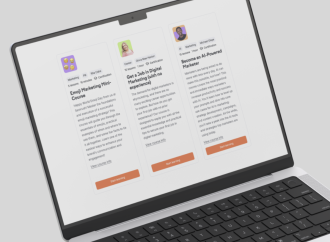Successful Entrepreneurs Who Started as Side Hustlers Many successful entrepreneurs didn’t dive straight into building huge businesses. Instead, they balanced day jobs, school, or entirely different careers while testing their ideas on the side. Starting small gives founders the chance to experiment, learn from their mistakes, and improve their products or services without putting everything

Successful Entrepreneurs Who Started as Side Hustlers
Many successful entrepreneurs didn’t dive straight into building huge businesses. Instead, they balanced day jobs, school, or entirely different careers while testing their ideas on the side. Starting small gives founders the chance to experiment, learn from their mistakes, and improve their products or services without putting everything at risk. The stories below show that a simple side hustle can grow into a thriving empire when driven by passion, persistence, and the willingness to work outside regular hours.
Steve Wozniak & Steve Jobs: Apple’s Humble Beginnings
Apple started in the 1970s when Steve Wozniak and Steve Jobs teamed up to create the first Apple computers in Jobs’ parents’ garage. Wozniak worked on circuit boards and programming during his free time, while Jobs used his marketing and design skills to package the product for hobbyists. At first, they aimed to create user-friendly computers for tech enthusiasts. What began as a side project soon became Apple, now one of the biggest names in tech.
Key takeaway: Starting small and focusing on a niche audience can help build loyal supporters early on.
Human factor: Wozniak and Jobs combined technical expertise with entrepreneurial vision, showing that collaboration is key to success in a side hustle.
Sara Blakely: The Rise of Spanx
Before creating Spanx, Sara Blakely sold fax machines door-to-door for Danka. She came up with the idea for Spanx—body-shaping undergarments—after struggling with the discomfort of traditional pantyhose. To solve this problem, Blakely cut off the feet of a pair of pantyhose to create her first prototype. This quick DIY hack turned into a late-night project where she researched materials, filed patents, and tested the product with friends. After landing a deal with Neiman Marcus to sell Spanx, the brand skyrocketed into a billion-dollar business.
Key takeaway: Identifying a personal frustration and solving it can lead to a new market opportunity.
Human factor: Blakely’s determination and willingness to handle every detail—like patenting the product and building her personal brand—show the hard work typical of side hustlers.
Mark Cuban: From Hustles to Tech Empire
Mark Cuban is known as the owner of the Dallas Mavericks and a panelist on Shark Tank, but his entrepreneurial journey started much earlier. As a 12-year-old, he sold garbage bags door-to-door to earn extra cash, setting the stage for a life of side hustles. After college, he worked as a computer software salesman, but he spent his spare time developing his own tech services. When he got fired from his job, Cuban used his sales experience and contacts to start MicroSolutions, which quickly grew into a successful software company. He later sold it for millions, paving the way for his future ventures.
Key takeaway: Even small hustles can teach important sales skills and build valuable relationships.
Human factor: Cuban’s resilience and ability to spot opportunities, even after setbacks like losing his job, highlight his self-confidence and determination.
Daymond John: FUBU’s Rise from Red Lobster
Daymond John, who later became famous on Shark Tank, worked part-time at Red Lobster while building his clothing brand, FUBU (For Us By Us). He started by selling hats and t-shirts from his mother’s house and, along with his co-founders, created small batches of apparel after hours. FUBU’s big break came when their products appeared in hip-hop music videos, thanks to smart marketing by placing them on emerging rap stars. As FUBU grew, John eventually left Red Lobster to run the brand full-time.
Key takeaway: Tapping into cultural trends, like 1990s hip-hop, can significantly boost a brand’s visibility.
Human factor: Balancing a regular job while pursuing a passion project is common among entrepreneurs. Persistence and a true hustle can help turn a side project into a full-time career.
Kevin Plank: Under Armour’s Basement Startup
Kevin Plank, a University of Maryland football player, got tired of sweaty cotton T-shirts and decided to create moisture-wicking athletic gear. He started designing the products in his grandmother’s basement while balancing his studies and sports. After graduating, Plank focused on refining his prototypes and distributing them to athletes. What began as a small venture eventually became Under Armour, a brand that competes with giants like Nike and Adidas.
Key takeaway: Solving a personal problem can lead to solutions that benefit a wider audience, especially in the sports and fitness industry.
Human factor: Juggling school, sports, and a side hustle showcases Plank’s dedication and commitment to his dream.
Why Side Hustles Often Succeed
Many side hustlers have the benefit of a safety net—whether it’s an existing job or steady income—which allows them to experiment without major risk. This setup encourages creativity, as mistakes aren’t disastrous, giving founders the chance to refine their products and services. Additionally, side hustlers often build strong relationships with early customers by approaching them in a personal way and gathering direct feedback. By the time they go full-time, they’ve already tested their ideas and built a loyal following.
Tips for Aspiring Side-Hustling Entrepreneurs
If you’re thinking about starting your own side hustle, focus on a genuine passion or an everyday problem you want to solve. This authenticity will keep you motivated while balancing other responsibilities. Start small—create a minimal viable product (MVP), get real-world feedback, and adjust accordingly. Don’t be afraid to seek help—connect with other professionals, join local business communities, or use social media to find early supporters and mentors.
Value your time: Make the most of your hustle hours, but be mindful of avoiding burnout.
Stay open to learning: Every mistake is an opportunity to refine your approach and move closer to your ultimate vision.

















Leave a Comment
Your email address will not be published. Required fields are marked with *